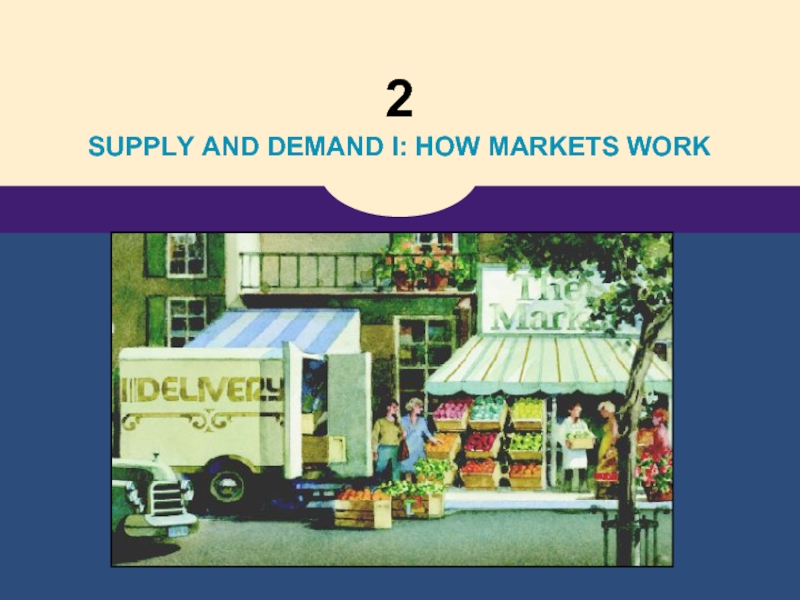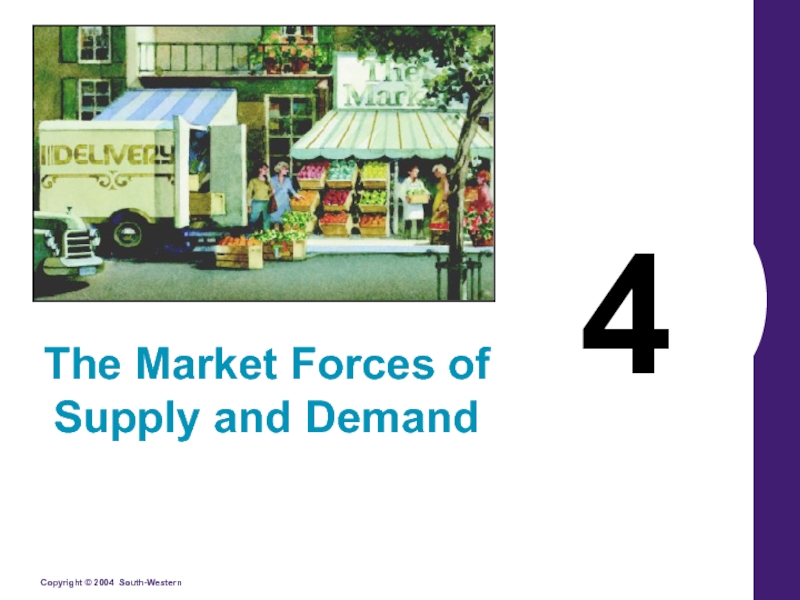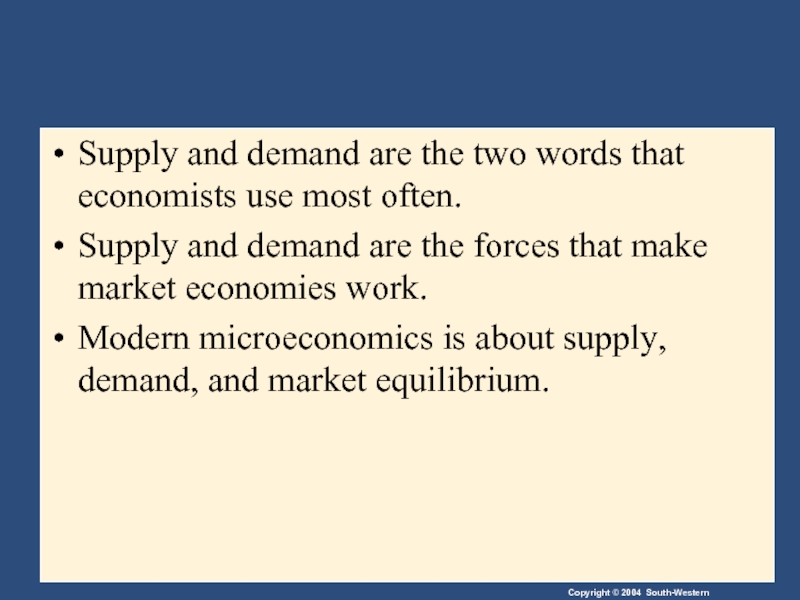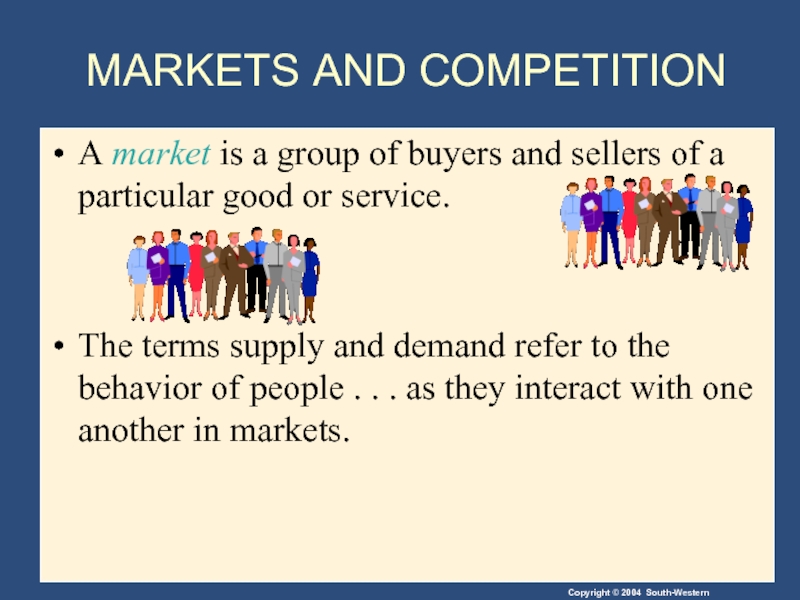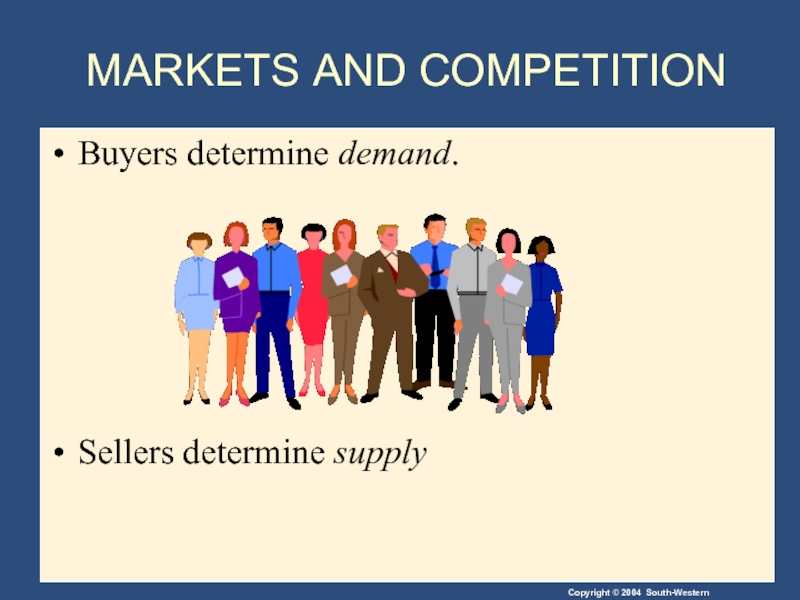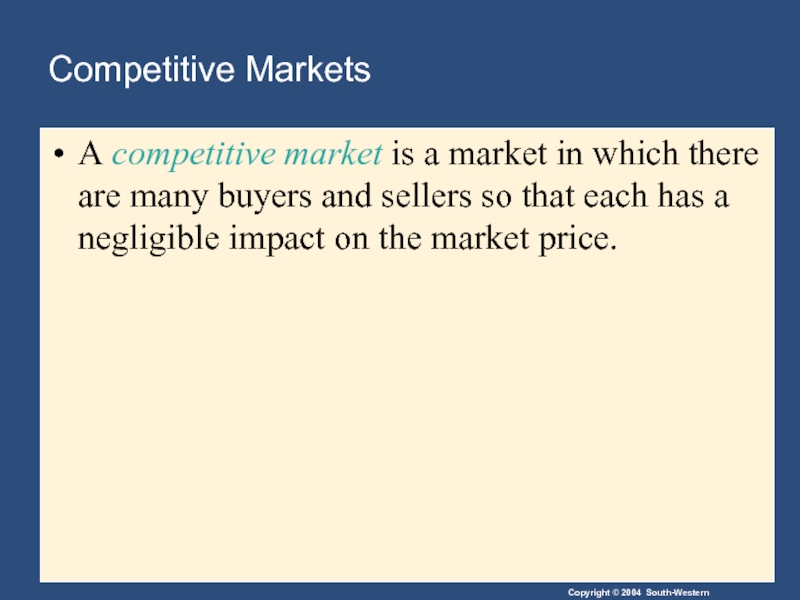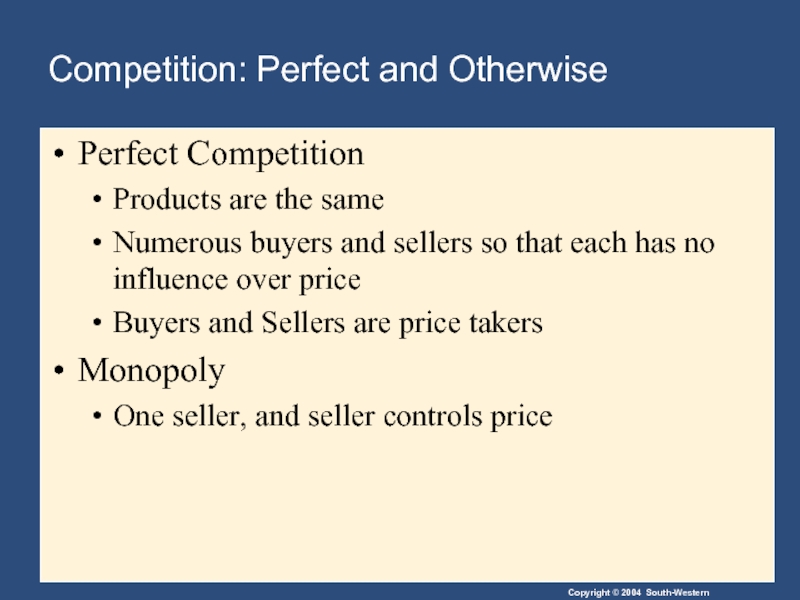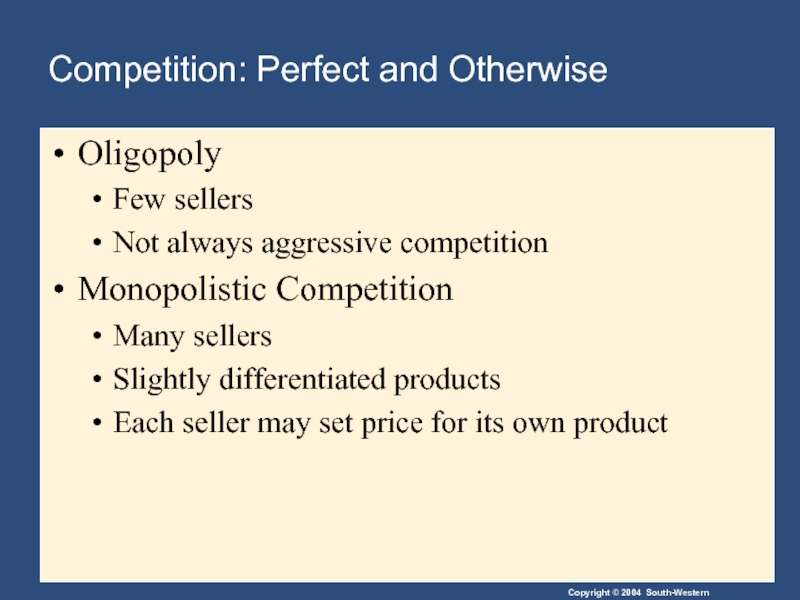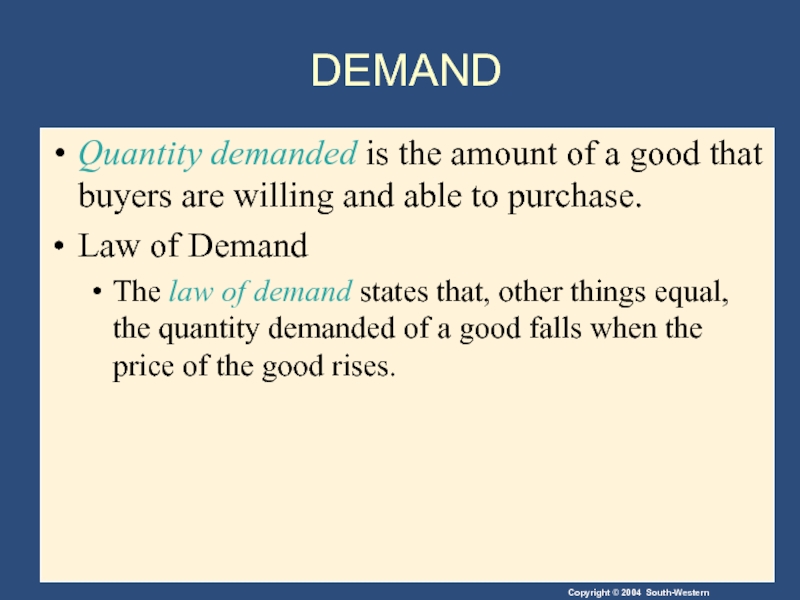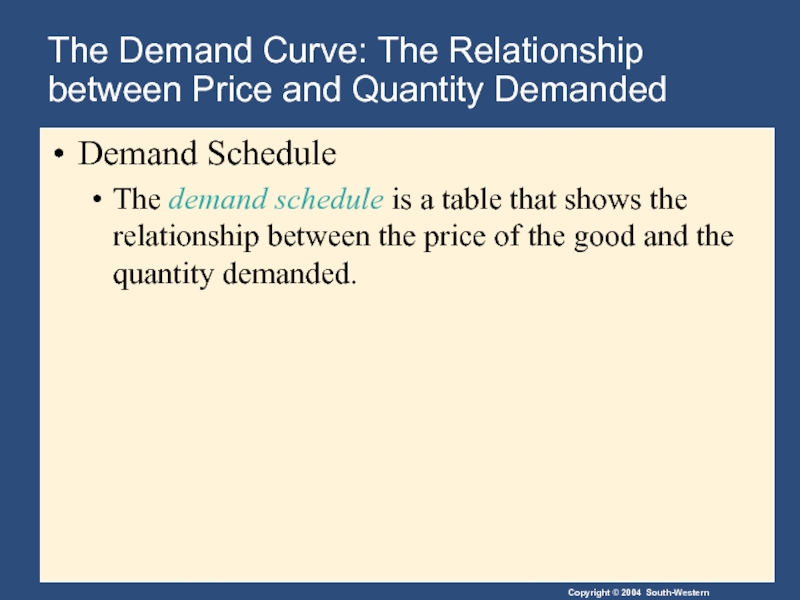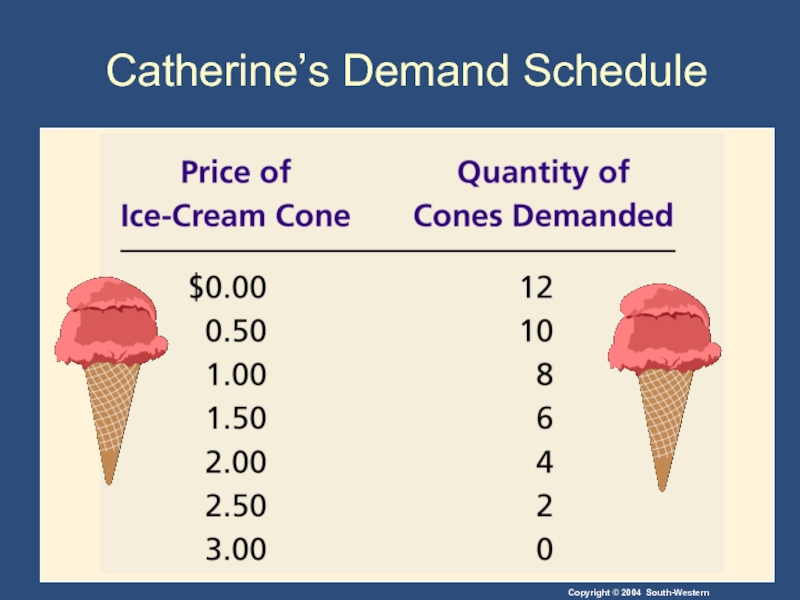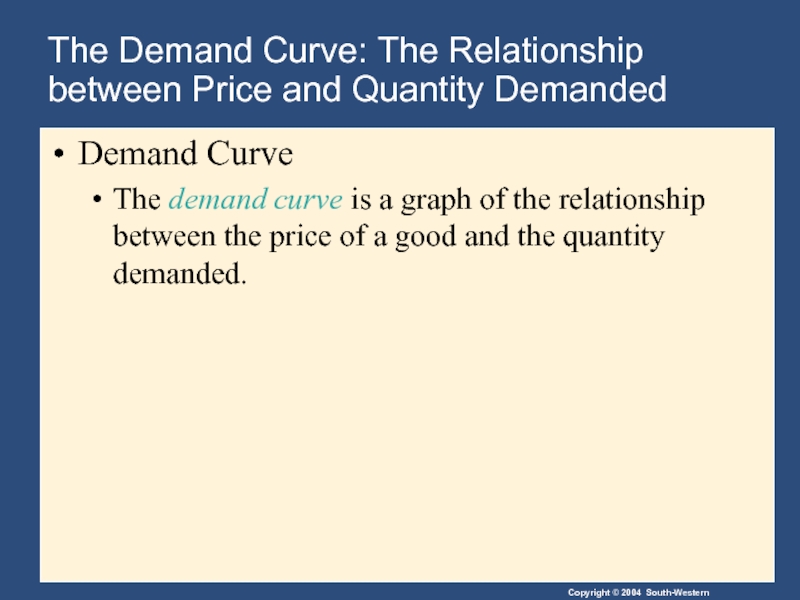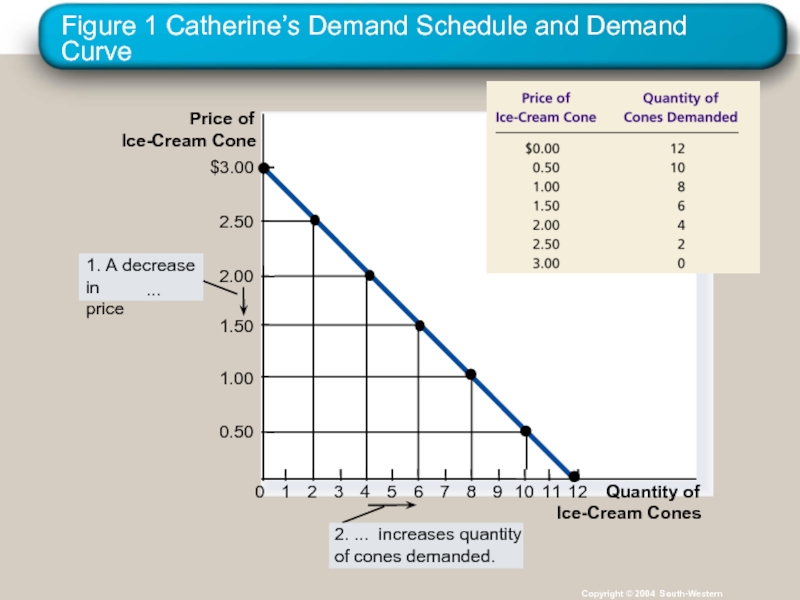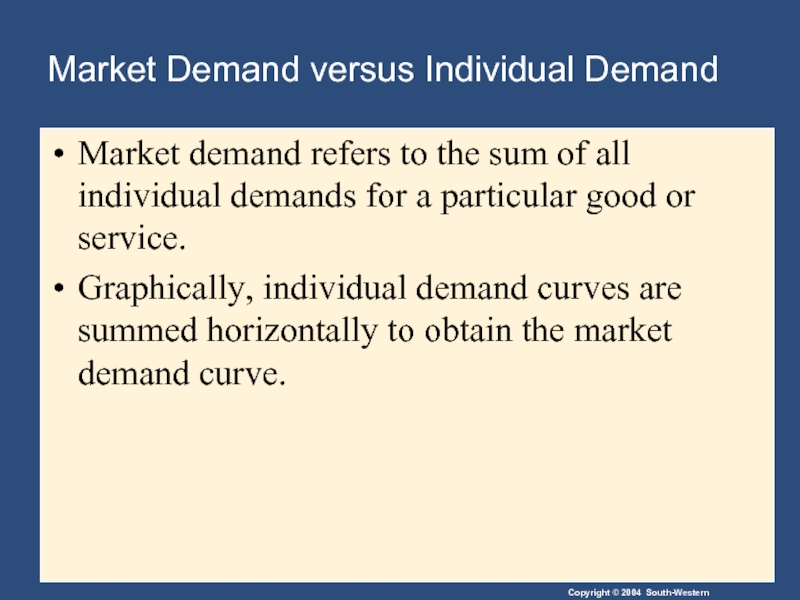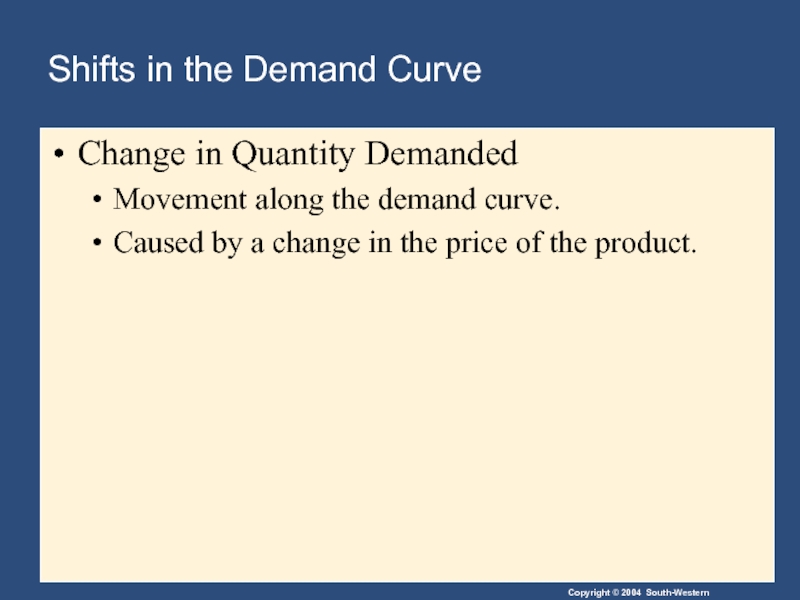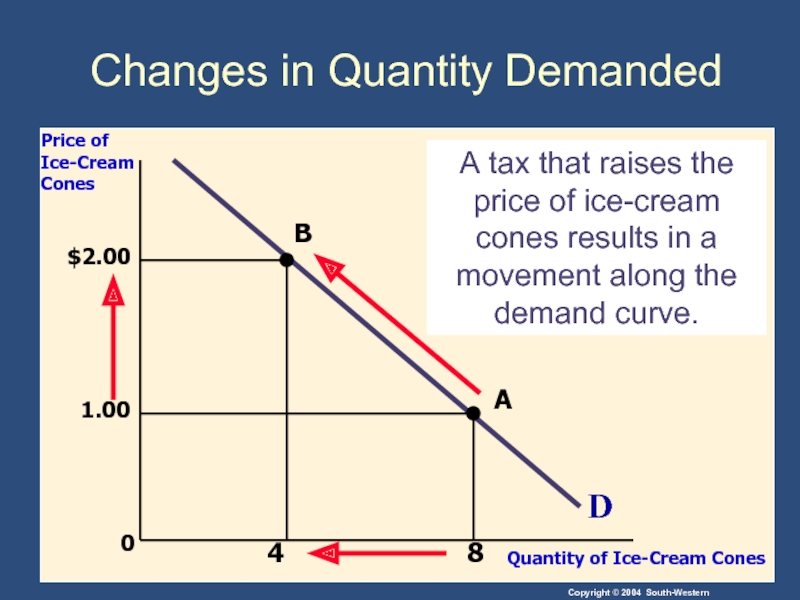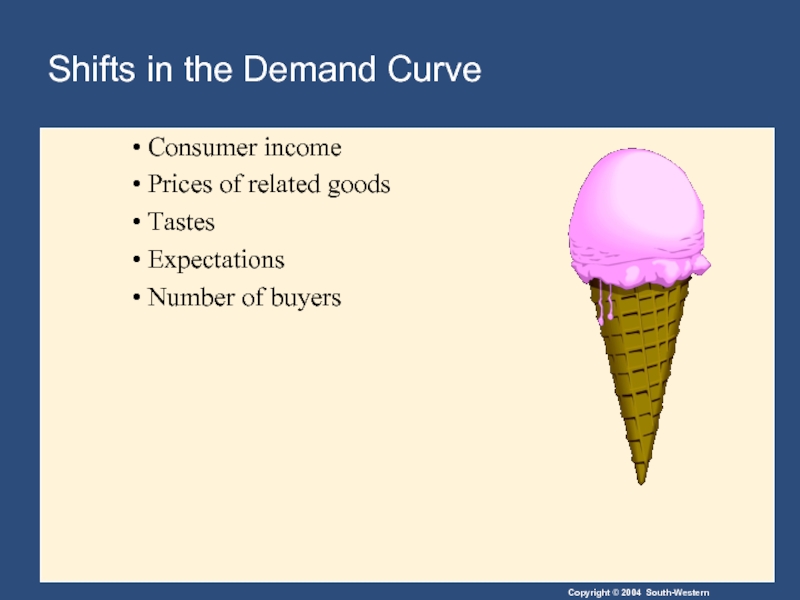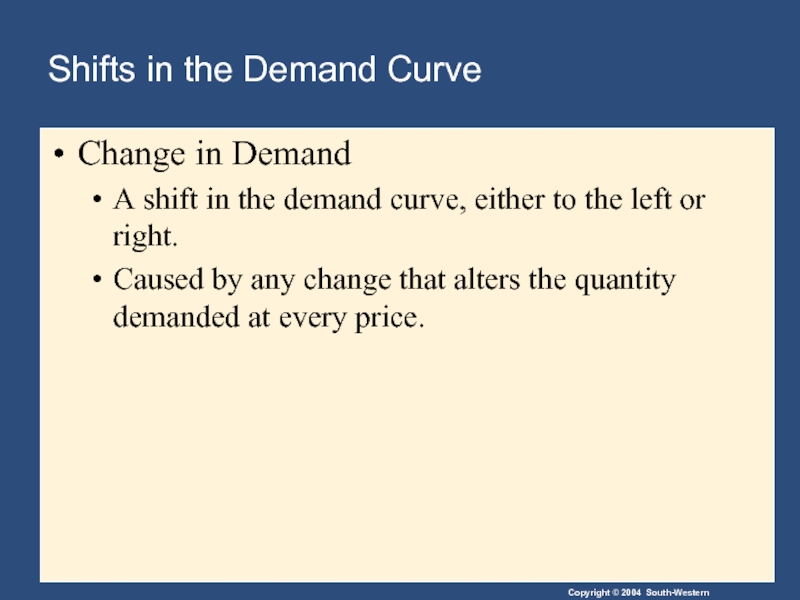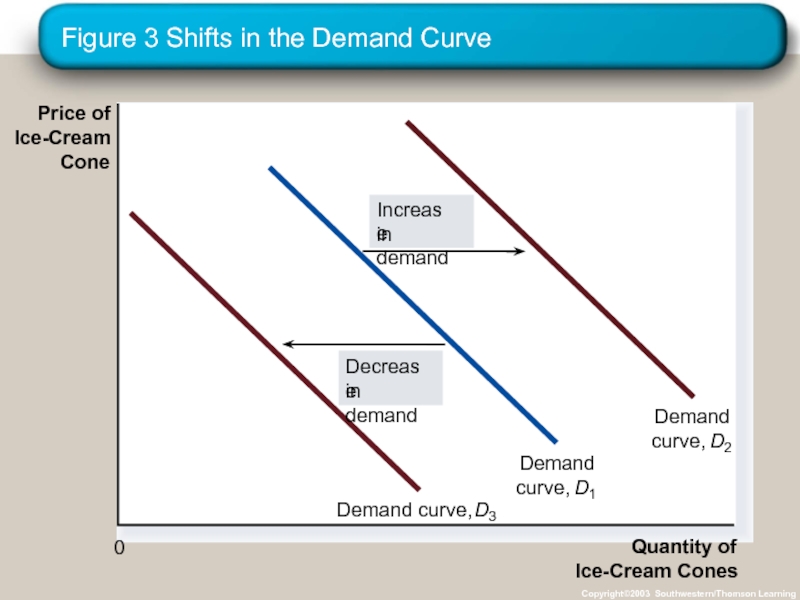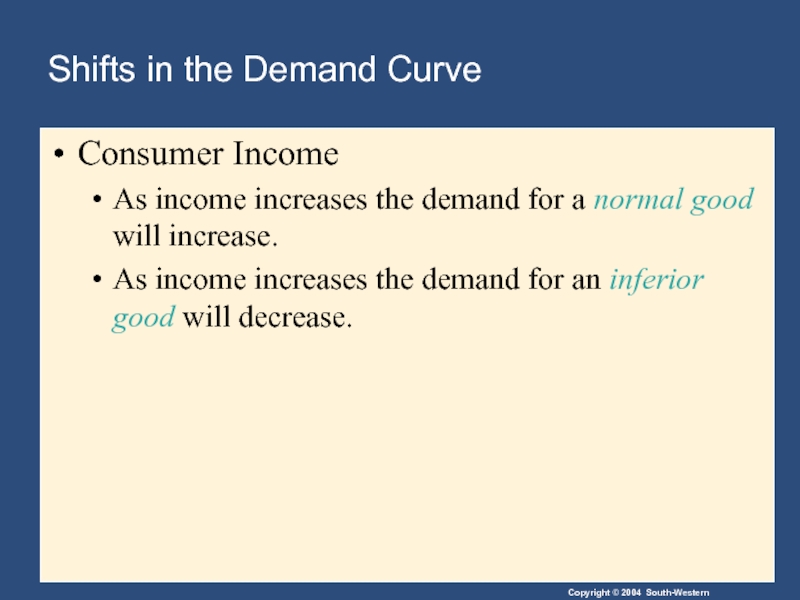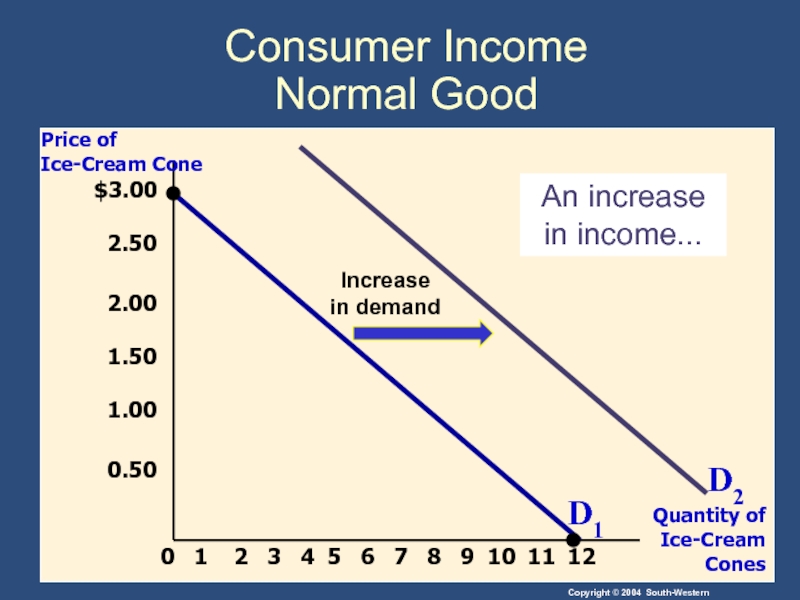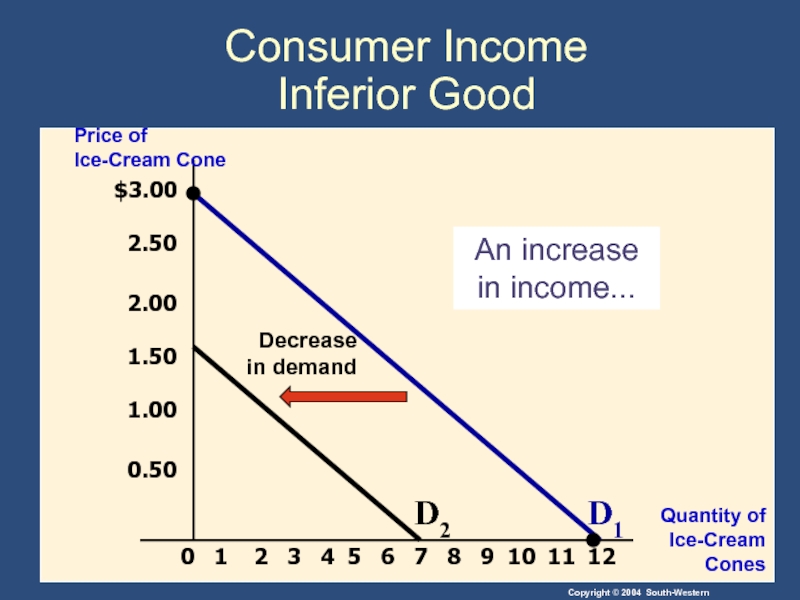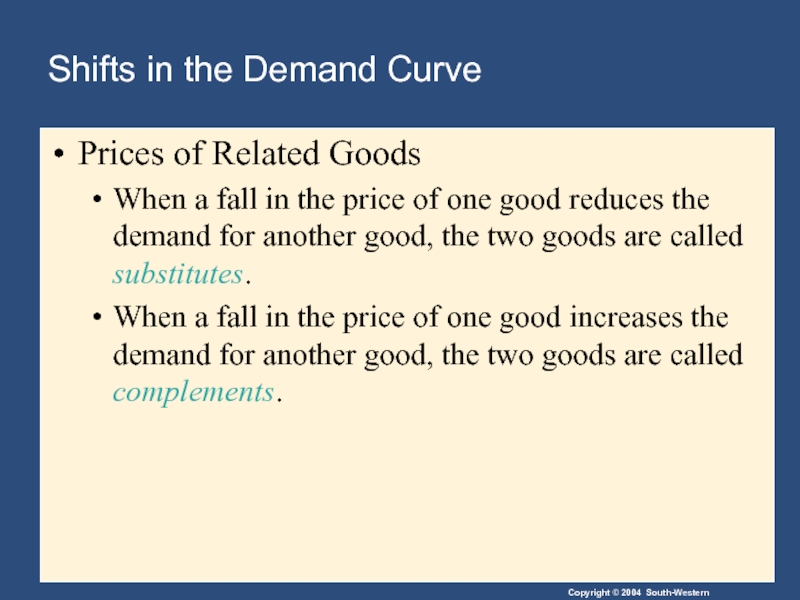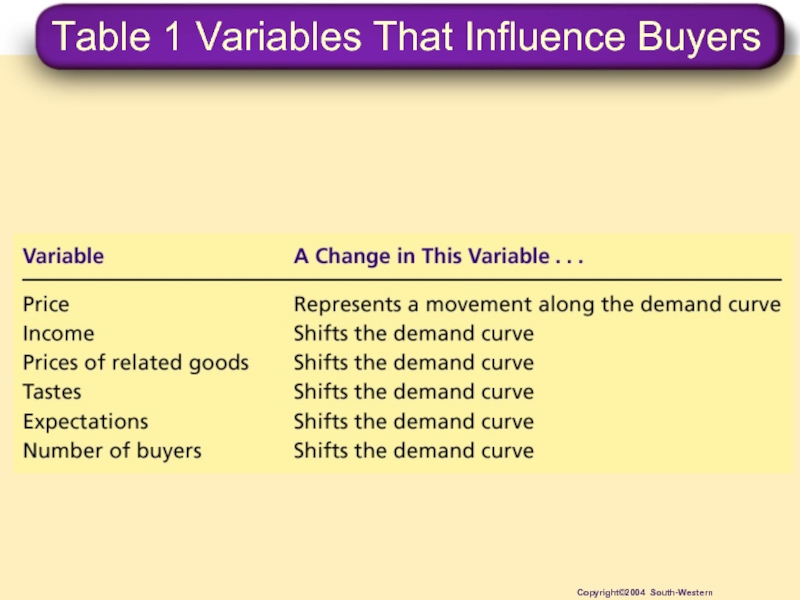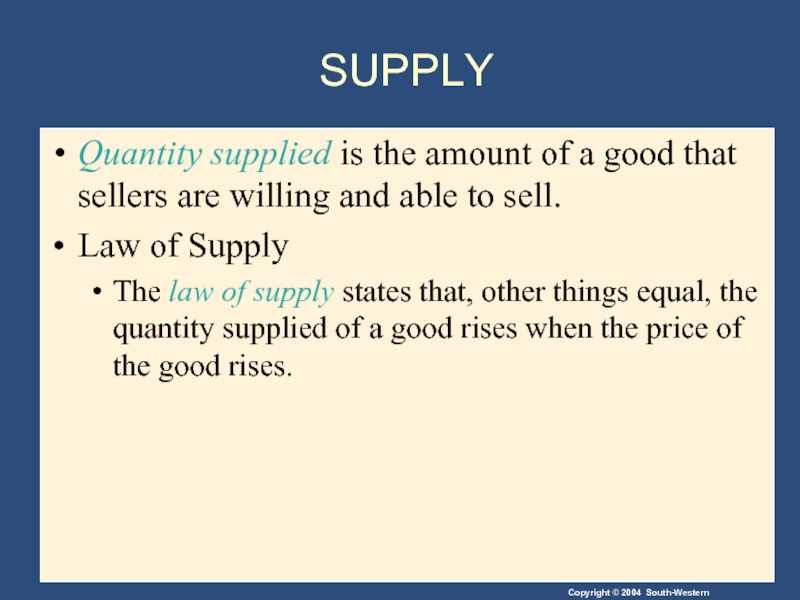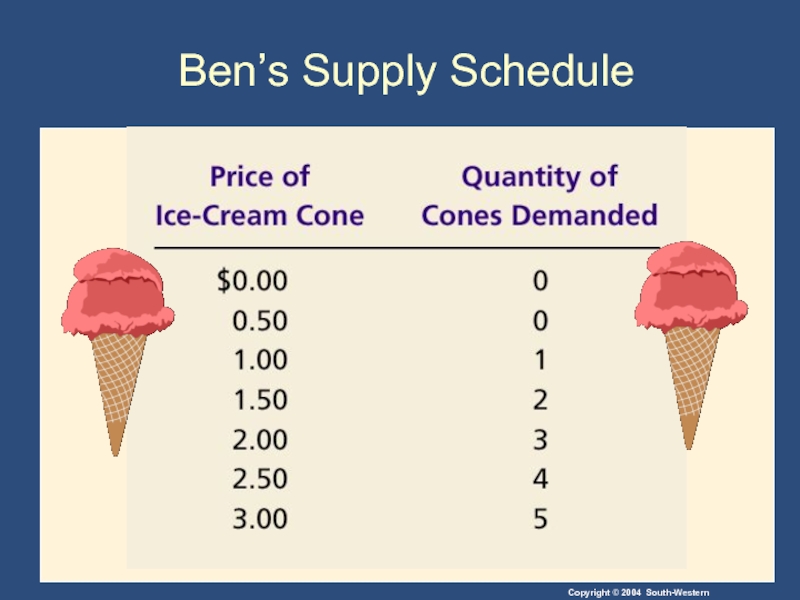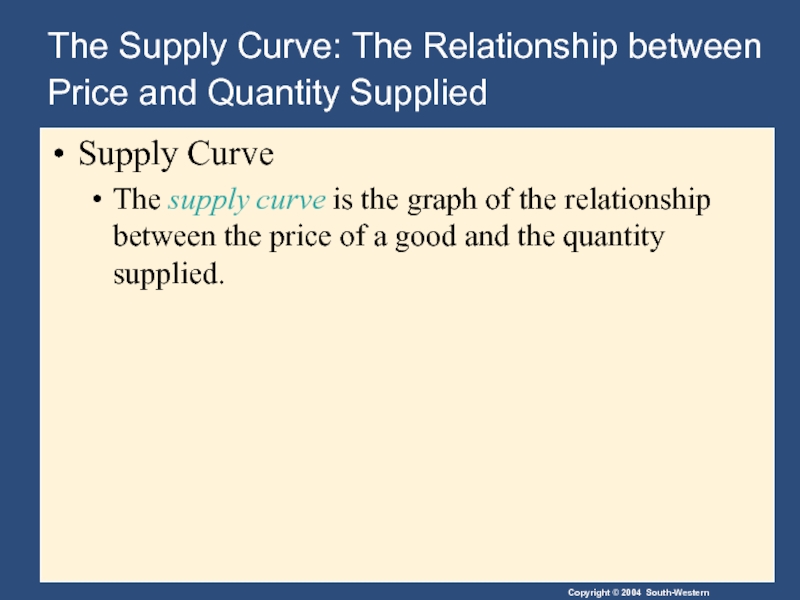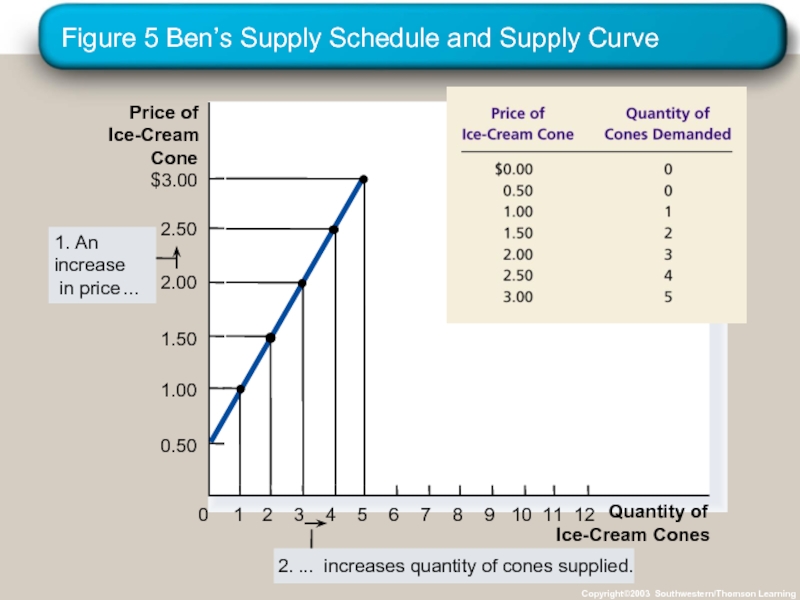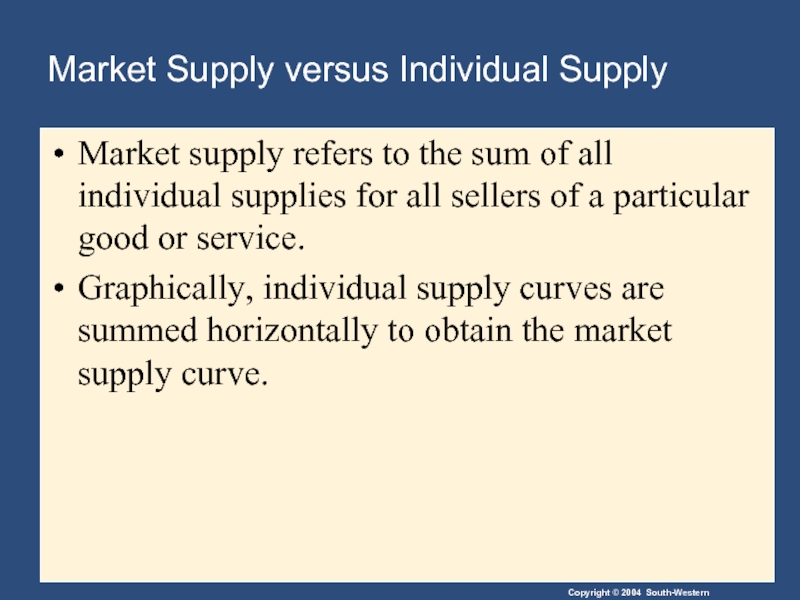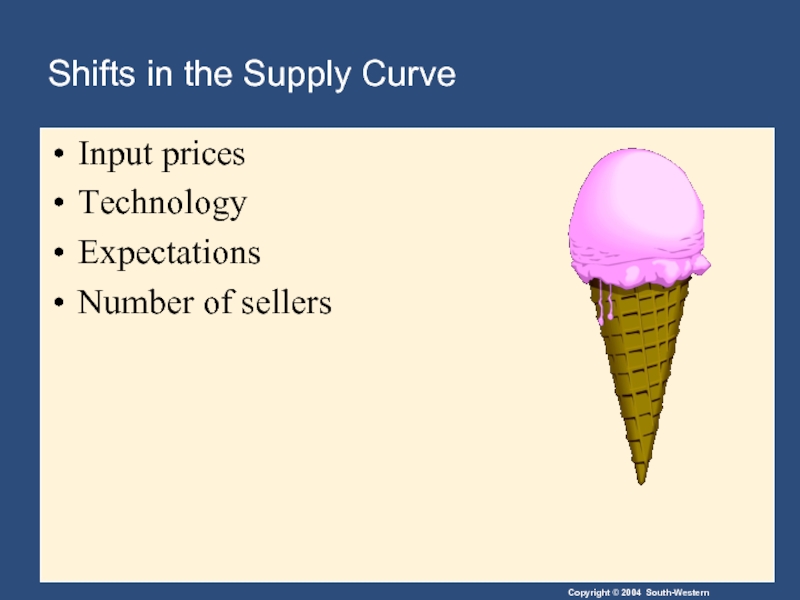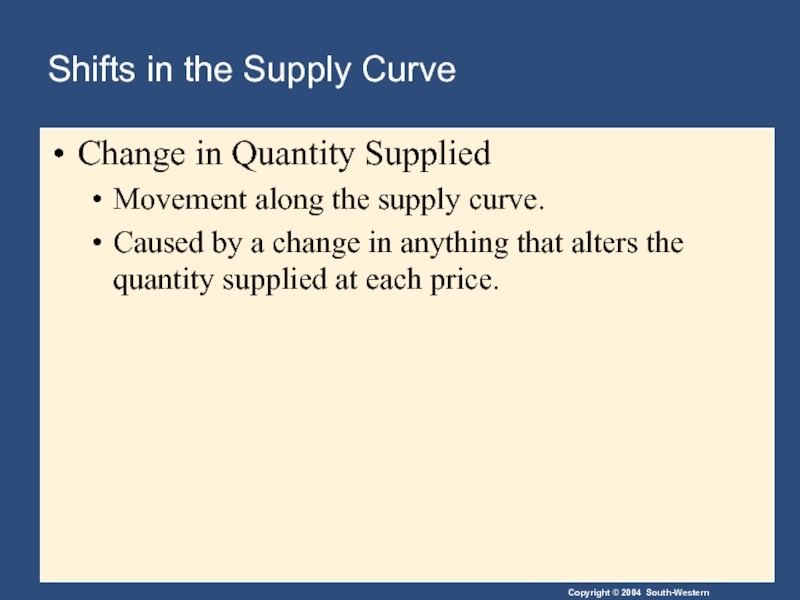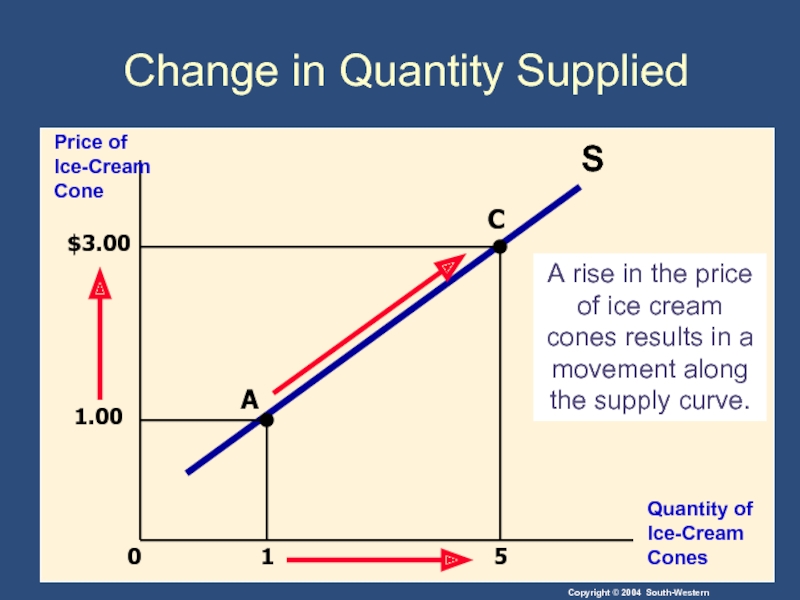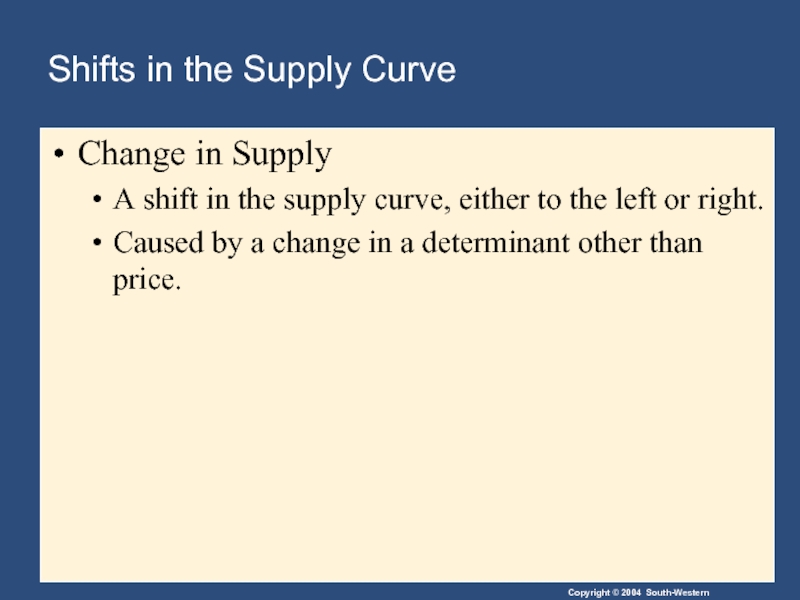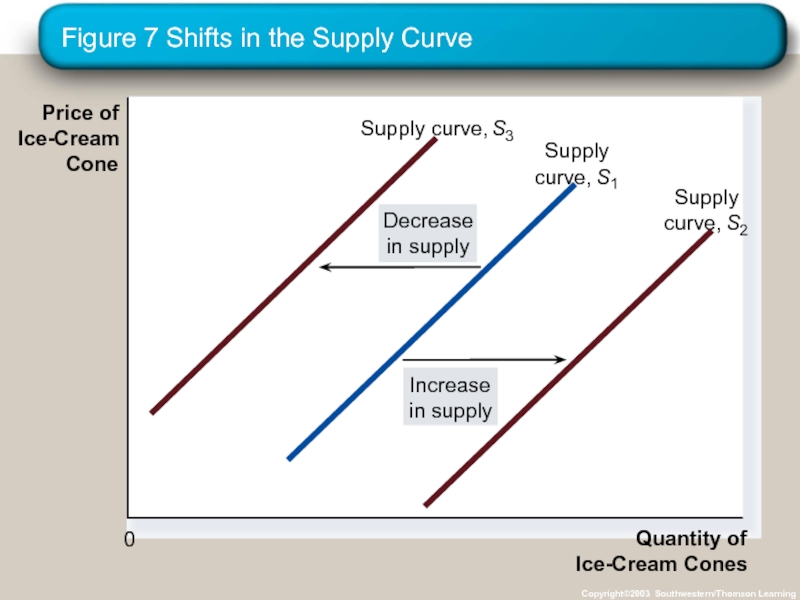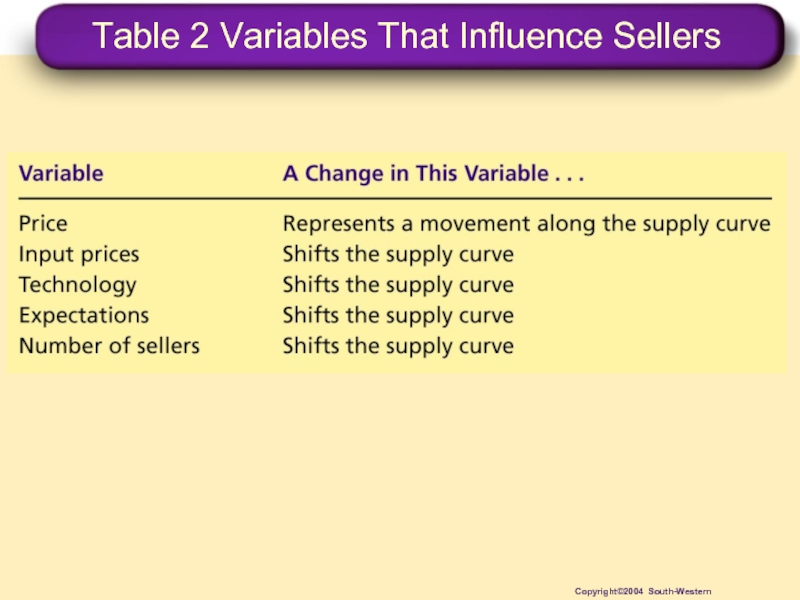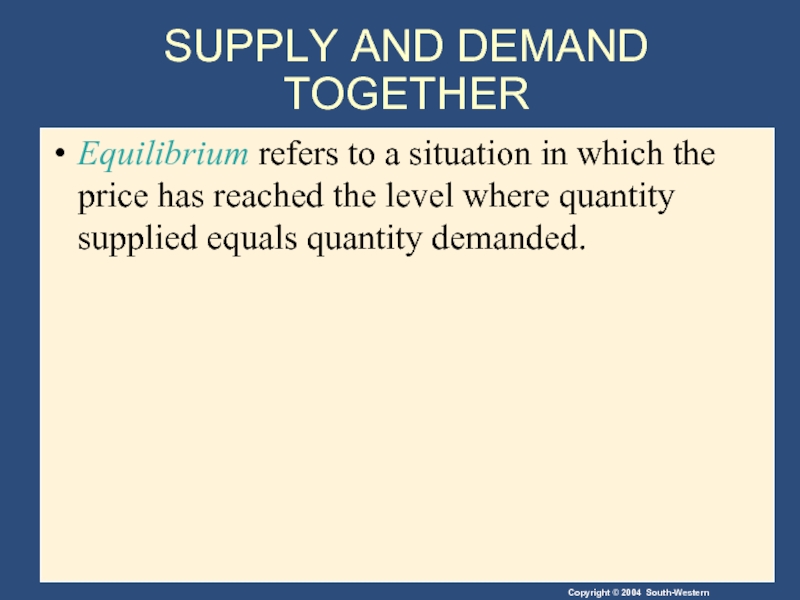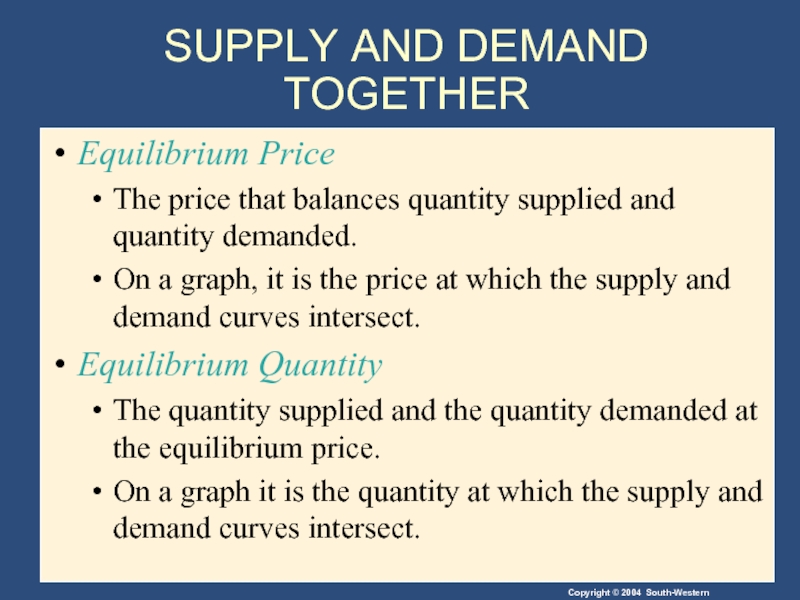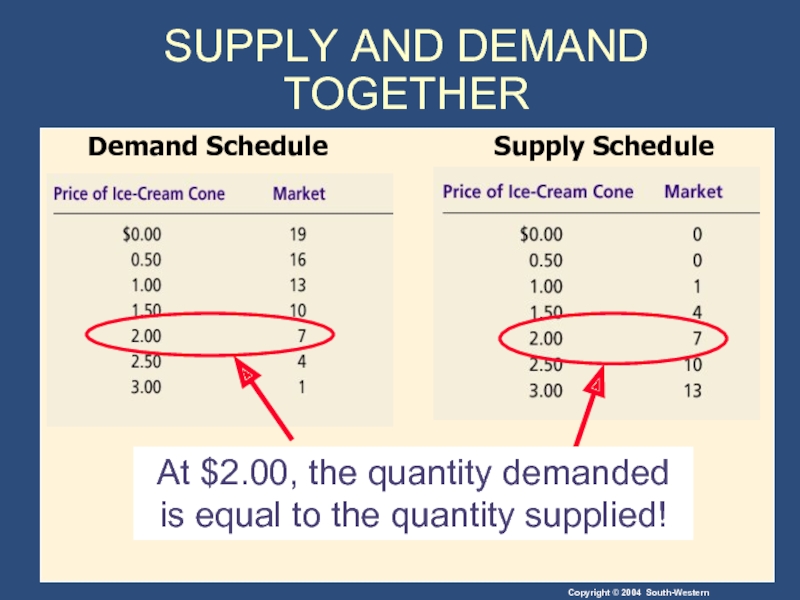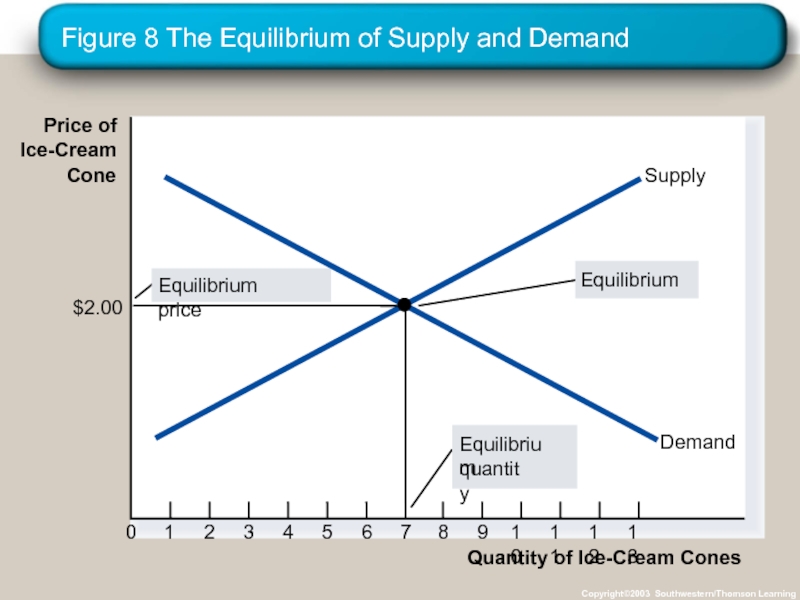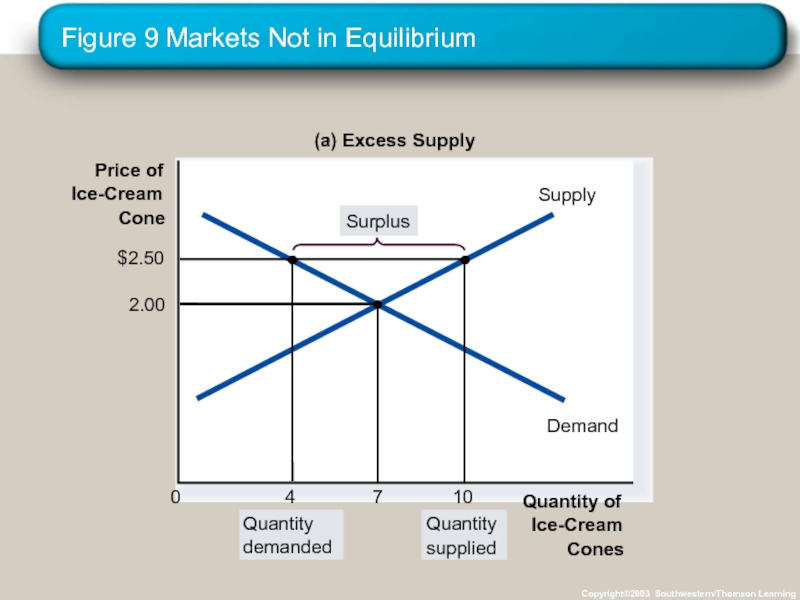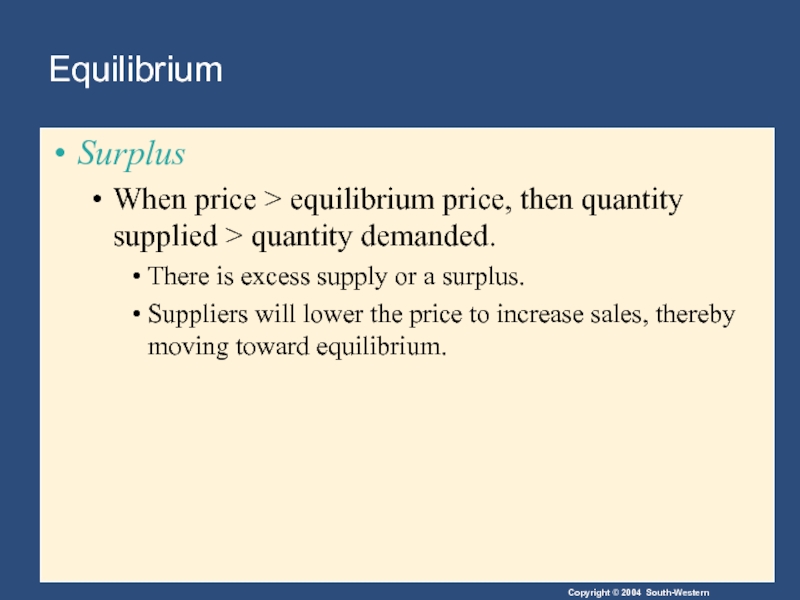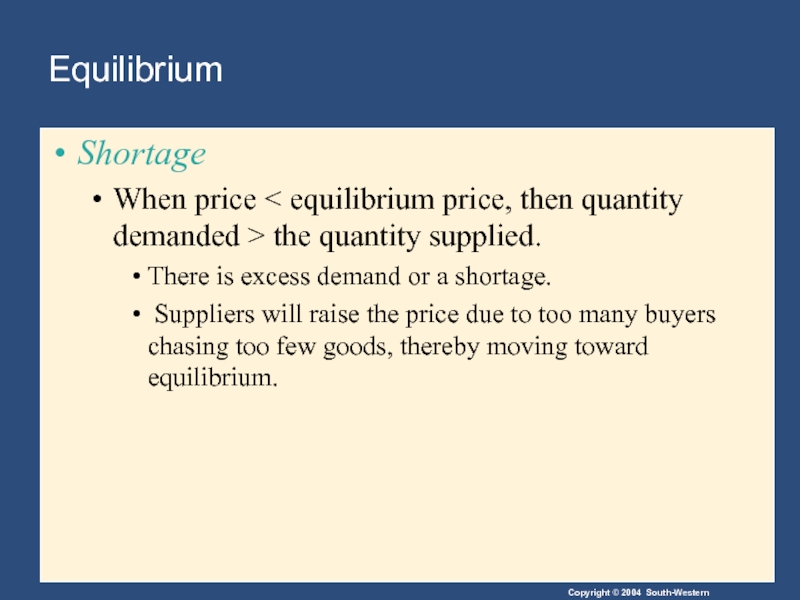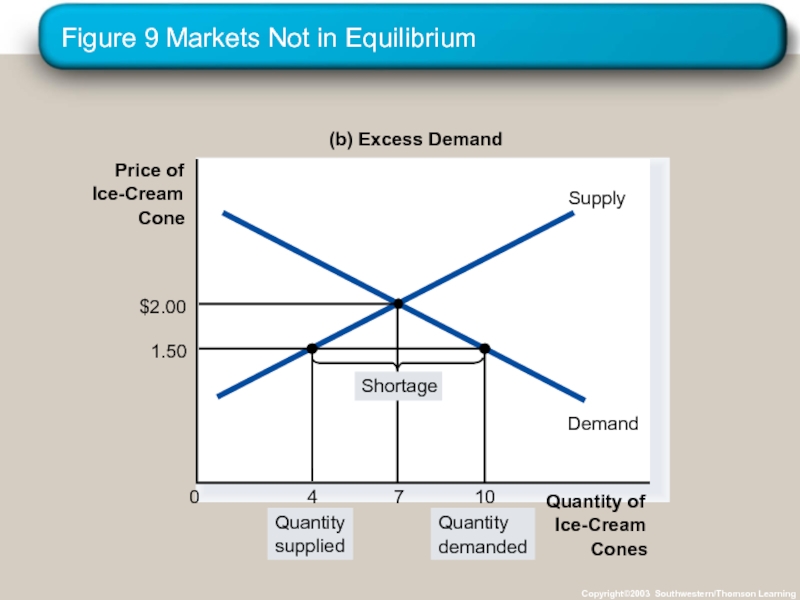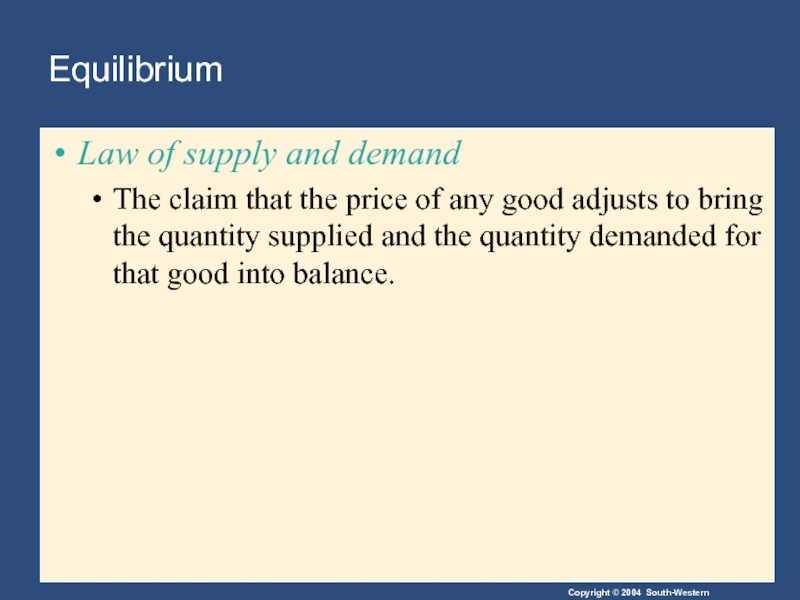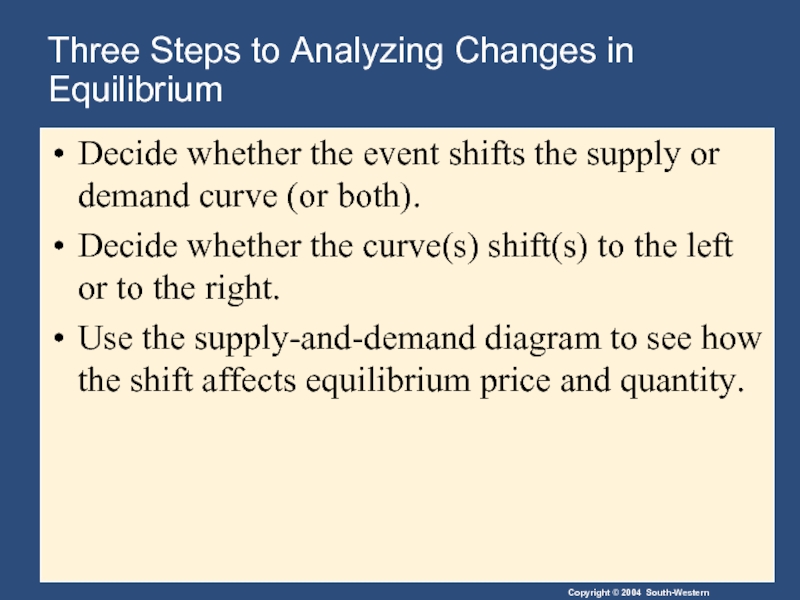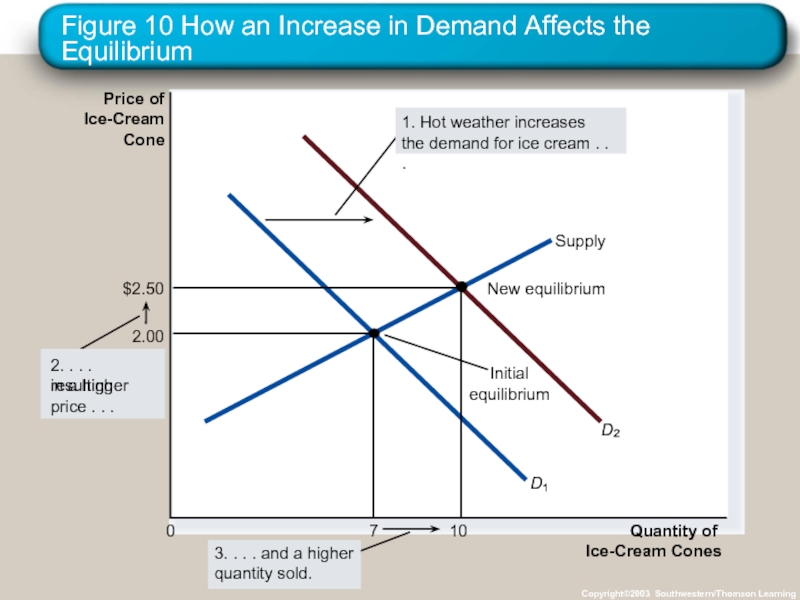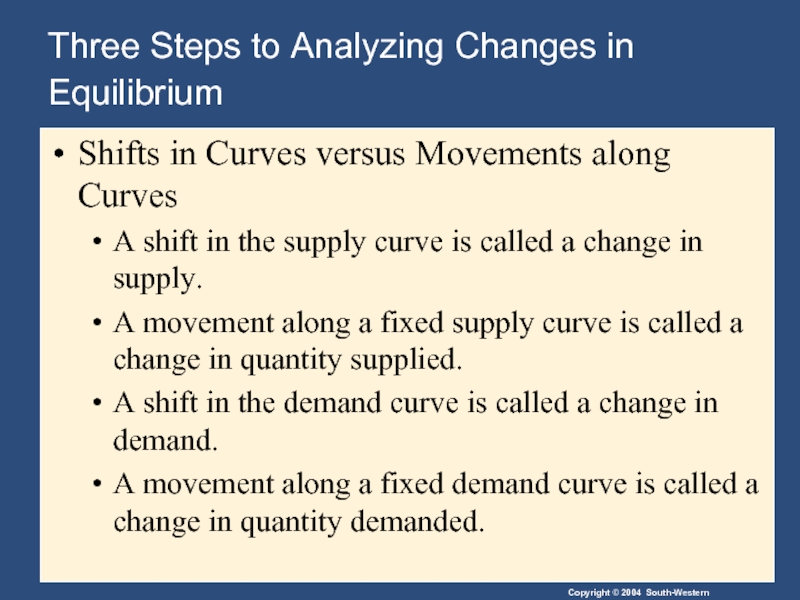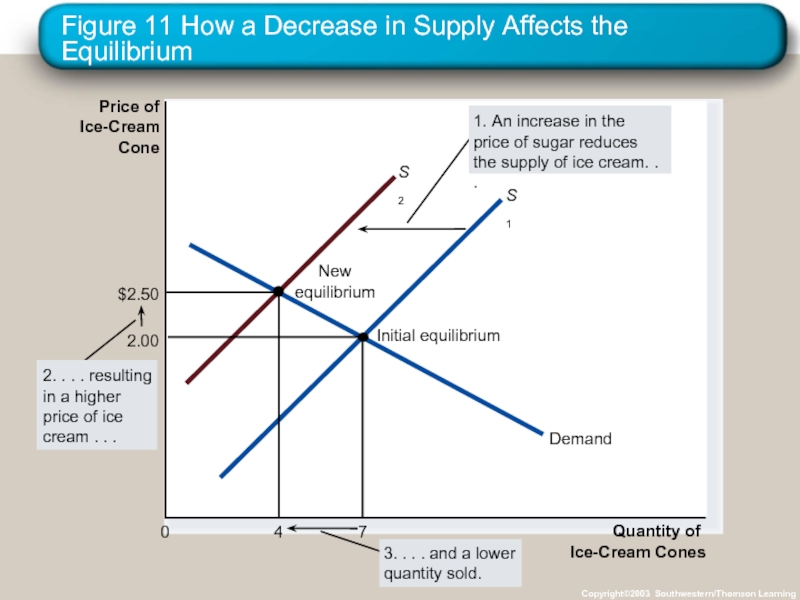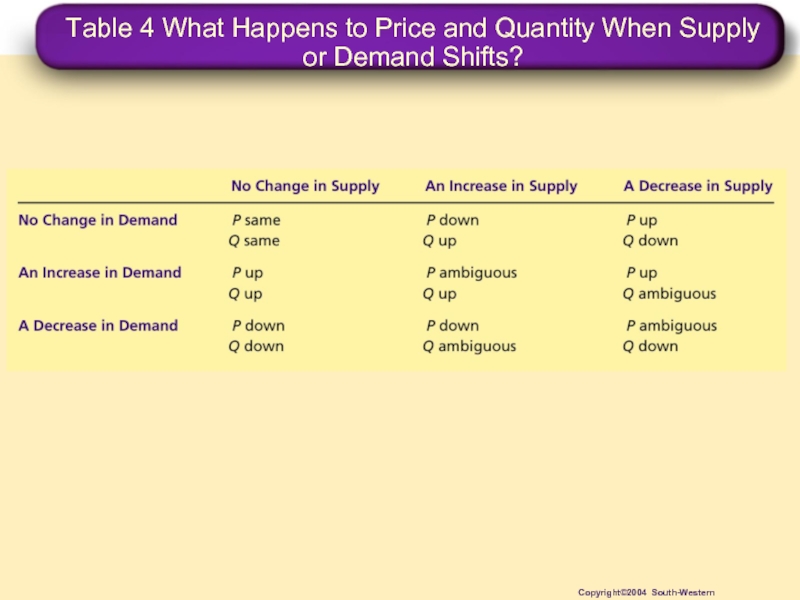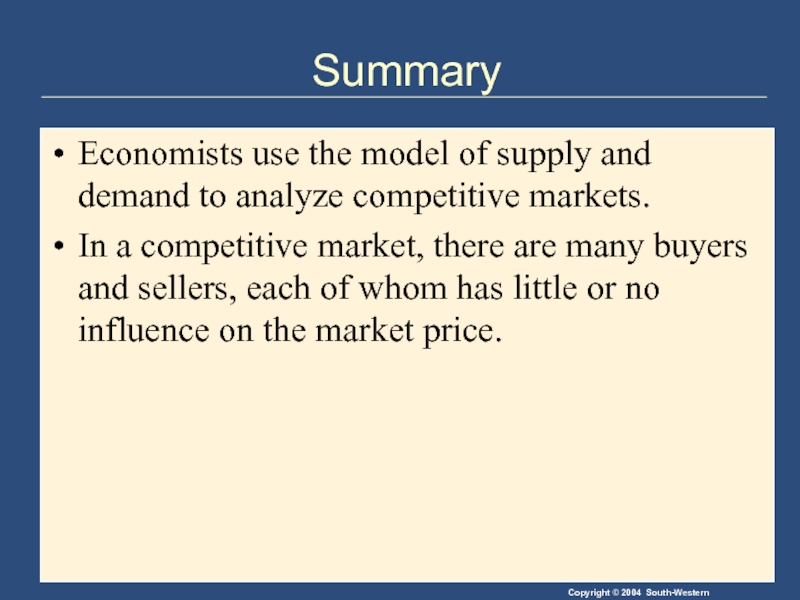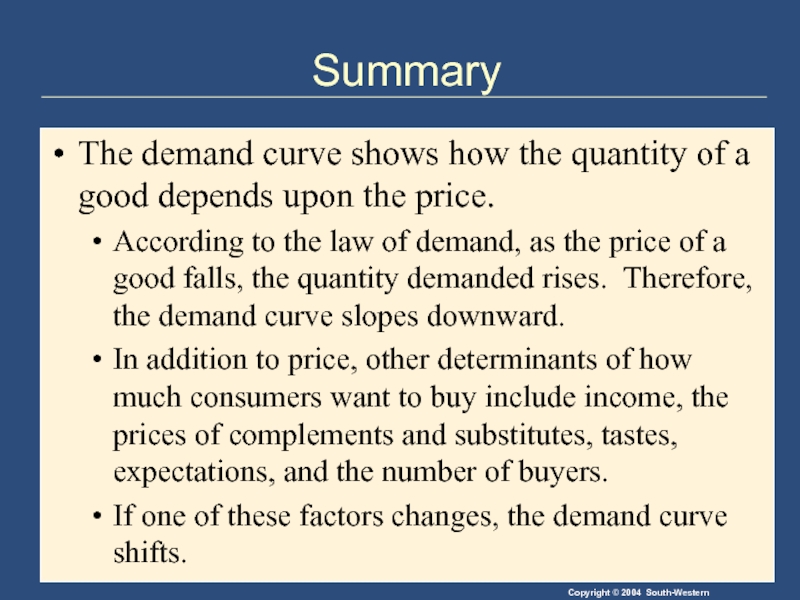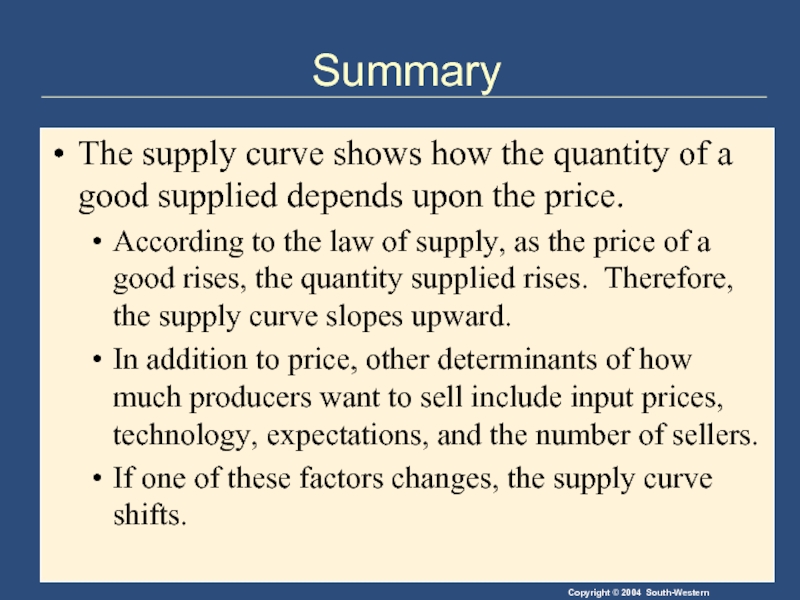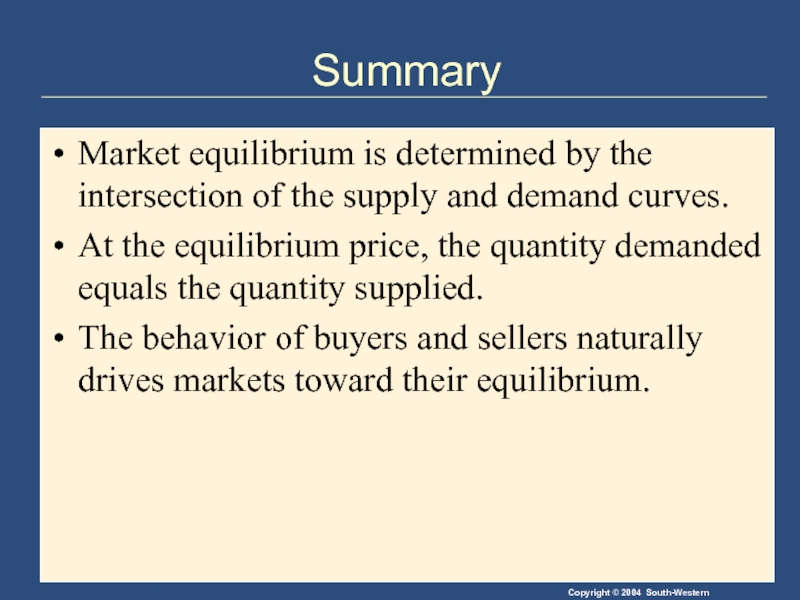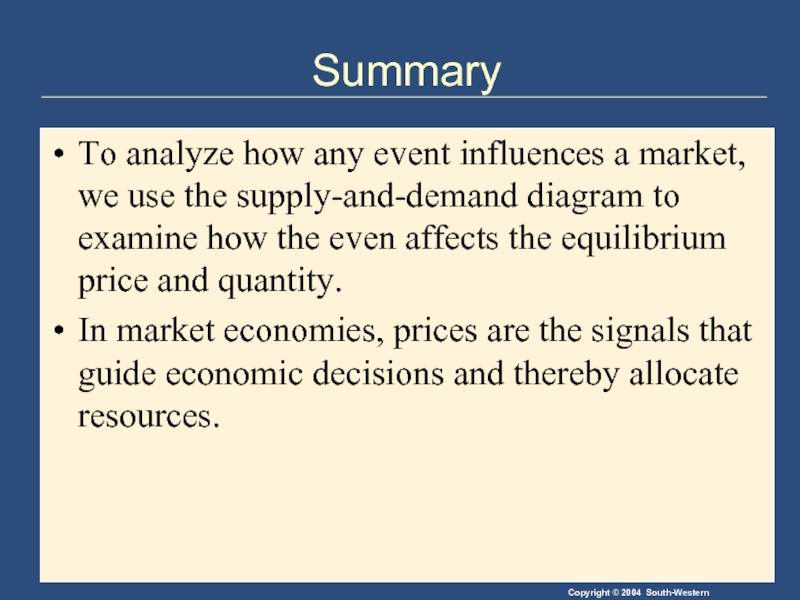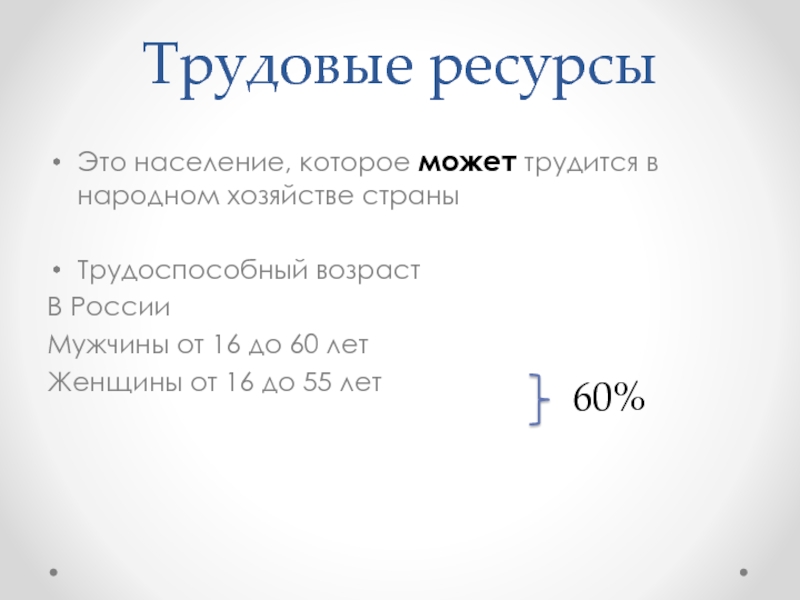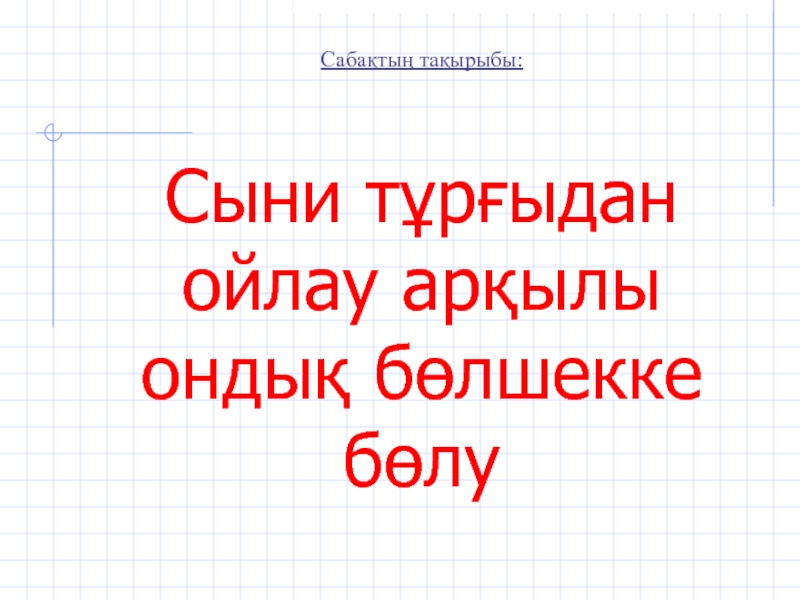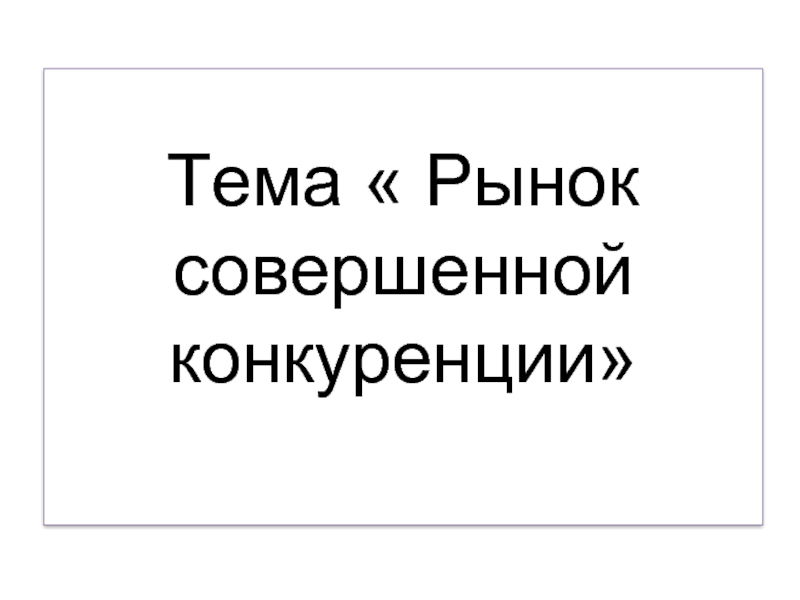- Главная
- Разное
- Дизайн
- Бизнес и предпринимательство
- Аналитика
- Образование
- Развлечения
- Красота и здоровье
- Финансы
- Государство
- Путешествия
- Спорт
- Недвижимость
- Армия
- Графика
- Культурология
- Еда и кулинария
- Лингвистика
- Английский язык
- Астрономия
- Алгебра
- Биология
- География
- Детские презентации
- Информатика
- История
- Литература
- Маркетинг
- Математика
- Медицина
- Менеджмент
- Музыка
- МХК
- Немецкий язык
- ОБЖ
- Обществознание
- Окружающий мир
- Педагогика
- Русский язык
- Технология
- Физика
- Философия
- Химия
- Шаблоны, картинки для презентаций
- Экология
- Экономика
- Юриспруденция
Supply and demand i: how markets work презентация
Содержание
- 1. Supply and demand i: how markets work
- 2. 4 The Market Forces of Supply and Demand
- 3. Supply and demand are the
- 4. A market is a group of buyers
- 5. MARKETS AND COMPETITION Buyers determine demand. Sellers determine supply
- 6. Competitive Markets A competitive market is a
- 7. Perfect Competition Products are the same Numerous
- 8. Oligopoly Few sellers Not always aggressive competition
- 9. DEMAND Quantity demanded is the amount of
- 10. The Demand Curve: The Relationship between Price
- 11. Catherine’s Demand Schedule
- 12. The Demand Curve: The Relationship between Price
- 13. Figure 1 Catherine’s Demand Schedule and Demand
- 14. Market Demand versus Individual Demand Market demand
- 15. Shifts in the Demand Curve Change in
- 16. 0 D Price of Ice-Cream Cones
- 17. Shifts in the Demand Curve Consumer income
- 18. Shifts in the Demand Curve Change in
- 19. Figure 3 Shifts in the Demand Curve
- 20. Shifts in the Demand Curve Consumer Income
- 21. $3.00 2.50 2.00 1.50 1.00
- 22. $3.00 2.50 2.00 1.50 1.00
- 23. Shifts in the Demand Curve Prices of
- 24. Table 1 Variables That Influence Buyers Copyright©2004 South-Western
- 25. SUPPLY Quantity supplied is the amount of
- 26. The Supply Curve: The Relationship between Price
- 27. Ben’s Supply Schedule
- 28. The Supply Curve: The Relationship
- 29. Figure 5 Ben’s Supply Schedule and Supply
- 30. Market Supply versus Individual Supply Market supply
- 31. Shifts in the Supply Curve Input prices Technology Expectations Number of sellers
- 32. Shifts in the Supply Curve
- 33. 1 5 Price
- 34. Shifts in the Supply Curve Change in
- 35. Figure 7 Shifts in the Supply Curve
- 36. Table 2 Variables That Influence Sellers Copyright©2004 South-Western
- 37. SUPPLY AND DEMAND TOGETHER Equilibrium
- 38. SUPPLY AND DEMAND TOGETHER Equilibrium
- 39. At $2.00, the quantity demanded
- 40. Figure 8 The Equilibrium of Supply and
- 41. Figure 9 Markets Not in Equilibrium Copyright©2003
- 42. Equilibrium Surplus When price > equilibrium price,
- 43. Equilibrium Shortage When price < equilibrium price,
- 44. Figure 9 Markets Not in Equilibrium Copyright©2003
- 45. Equilibrium Law of supply and demand The
- 46. Three Steps to Analyzing Changes
- 47. Figure 10 How an Increase in Demand
- 48. Three Steps to Analyzing Changes in Equilibrium
- 49. Figure 11 How a Decrease in Supply
- 50. Table 4 What Happens to Price and Quantity When Supply or Demand Shifts? Copyright©2004 South-Western
- 51. Summary Economists use the model of supply
- 52. Summary The demand curve shows how the
- 53. Summary The supply curve shows how the
- 54. Summary Market equilibrium is determined by the
- 55. Summary To analyze how any event influences
Слайд 3
Supply and demand are the two words that economists use most
Supply and demand are the forces that make market economies work.
Modern microeconomics is about supply, demand, and market equilibrium.
Слайд 4A market is a group of buyers and sellers of a
The terms supply and demand refer to the behavior of people . . . as they interact with one another in markets.
MARKETS AND COMPETITION
Слайд 6Competitive Markets
A competitive market is a market in which there are
Слайд 7Perfect Competition
Products are the same
Numerous buyers and sellers so that each
Buyers and Sellers are price takers
Monopoly
One seller, and seller controls price
Competition: Perfect and Otherwise
Слайд 8Oligopoly
Few sellers
Not always aggressive competition
Monopolistic Competition
Many sellers
Slightly differentiated products
Each seller may
Competition: Perfect and Otherwise
Слайд 9DEMAND
Quantity demanded is the amount of a good that buyers are
Law of Demand
The law of demand states that, other things equal, the quantity demanded of a good falls when the price of the good rises.
Слайд 10The Demand Curve: The Relationship between Price and Quantity Demanded
Demand Schedule
The demand schedule is a table that shows the relationship between the price of the good and the quantity demanded.
Слайд 12The Demand Curve: The Relationship between Price and Quantity Demanded
Demand Curve
The demand curve is a graph of the relationship between the price of a good and the quantity demanded.
Слайд 13Figure 1 Catherine’s Demand Schedule and Demand Curve
Copyright © 2004 South-Western
Price
Ice-Cream Cone
0
2.50
2.00
1.50
1.00
0.50
1
2
3
4
5
6
7
8
9
10
11
Quantity of
Ice-Cream Cones
$3.00
12
Слайд 14Market Demand versus Individual Demand
Market demand refers to the sum of
Graphically, individual demand curves are summed horizontally to obtain the market demand curve.
Слайд 15Shifts in the Demand Curve
Change in Quantity Demanded
Movement along the demand
Caused by a change in the price of the product.
Слайд 160
D
Price of Ice-Cream
Cones
Quantity of Ice-Cream Cones
A tax that raises the
A
8
1.00
Changes in Quantity Demanded
Слайд 17Shifts in the Demand Curve
Consumer income
Prices of related goods
Tastes
Expectations
Number of buyers
Слайд 18Shifts in the Demand Curve
Change in Demand
A shift in the demand
Caused by any change that alters the quantity demanded at every price.
Слайд 19Figure 3 Shifts in the Demand Curve
Copyright©2003 Southwestern/Thomson Learning
Price of
Ice-Cream
Cone
Quantity of
Ice-Cream
0
Слайд 20Shifts in the Demand Curve
Consumer Income
As income increases the demand for
As income increases the demand for an inferior good will decrease.
Слайд 21
$3.00
2.50
2.00
1.50
1.00
0.50
2
1
3
4
5
6
7
8
9
10
12
11
Price of Ice-Cream Cone
Quantity of Ice-Cream Cones
0
Increase
in demand
An increase in income...
D1
D2
Consumer
Слайд 22
$3.00
2.50
2.00
1.50
1.00
0.50
2
1
3
4
5
6
7
8
9
10
12
11
Price of Ice-Cream Cone
Quantity of Ice-Cream Cones
0
Decrease
in demand
An increase in income...
D1
D2
Consumer
Слайд 23Shifts in the Demand Curve
Prices of Related Goods
When a fall in
When a fall in the price of one good increases the demand for another good, the two goods are called complements.
Слайд 25SUPPLY
Quantity supplied is the amount of a good that sellers are
Law of Supply
The law of supply states that, other things equal, the quantity supplied of a good rises when the price of the good rises.
Слайд 26The Supply Curve: The Relationship between Price and Quantity Supplied
Supply Schedule
The
Слайд 28
The Supply Curve: The Relationship between Price and Quantity Supplied
Supply
The supply curve is the graph of the relationship between the price of a good and the quantity supplied.
Слайд 29Figure 5 Ben’s Supply Schedule and Supply Curve
Copyright©2003 Southwestern/Thomson Learning
Price of
Ice-Cream
Cone
0
2.50
2.00
1.50
1.00
1
2
3
4
5
6
7
8
9
10
11
Quantity
Ice-Cream Cones
$3.00
12
0.50
Слайд 30Market Supply versus Individual Supply
Market supply refers to the sum of
Graphically, individual supply curves are summed horizontally to obtain the market supply curve.
Слайд 32
Shifts in the Supply Curve
Change in Quantity Supplied
Movement along the supply
Caused by a change in anything that alters the quantity supplied at each price.
Слайд 33
1
5
Price of Ice-Cream Cone
Quantity of Ice-Cream Cones
0
S
1.00
A
C
A rise in
Change in Quantity Supplied
Слайд 34Shifts in the Supply Curve
Change in Supply
A shift in the supply
Caused by a change in a determinant other than price.
Слайд 35Figure 7 Shifts in the Supply Curve
Copyright©2003 Southwestern/Thomson Learning
Price of
Ice-Cream
Cone
Quantity of
Ice-Cream
0
Слайд 37
SUPPLY AND DEMAND TOGETHER
Equilibrium refers to a situation in which the
Слайд 38
SUPPLY AND DEMAND TOGETHER
Equilibrium Price
The price that balances quantity supplied and
On a graph, it is the price at which the supply and demand curves intersect.
Equilibrium Quantity
The quantity supplied and the quantity demanded at the equilibrium price.
On a graph it is the quantity at which the supply and demand curves intersect.
Слайд 39
At $2.00, the quantity demanded is equal to the quantity supplied!
SUPPLY
Demand Schedule
Supply Schedule
Слайд 40Figure 8 The Equilibrium of Supply and Demand
Copyright©2003 Southwestern/Thomson Learning
Price of
Ice-Cream
Cone
0
1
2
3
4
5
6
7
8
9
10
11
12
Quantity
13
Слайд 41Figure 9 Markets Not in Equilibrium
Copyright©2003 Southwestern/Thomson Learning
Price of
Ice-Cream
Cone
0
(a) Excess Supply
Quantity
Ice-Cream
Cones
Слайд 42Equilibrium
Surplus
When price > equilibrium price, then quantity supplied > quantity demanded.
There is excess supply or a surplus.
Suppliers will lower the price to increase sales, thereby moving toward equilibrium.
Слайд 43Equilibrium
Shortage
When price < equilibrium price, then quantity demanded > the quantity
There is excess demand or a shortage.
Suppliers will raise the price due to too many buyers chasing too few goods, thereby moving toward equilibrium.
Слайд 44Figure 9 Markets Not in Equilibrium
Copyright©2003 Southwestern/Thomson Learning
Price of
Ice-Cream
Cone
0
Quantity of
Ice-Cream
Cones
(b) Excess
Слайд 45Equilibrium
Law of supply and demand
The claim that the price of any
Слайд 46
Three Steps to Analyzing Changes in Equilibrium
Decide whether the event shifts
Decide whether the curve(s) shift(s) to the left or to the right.
Use the supply-and-demand diagram to see how the shift affects equilibrium price and quantity.
Слайд 47Figure 10 How an Increase in Demand Affects the Equilibrium
Copyright©2003 Southwestern/Thomson
Price of
Ice-Cream
Cone
0
Quantity of
Ice-Cream Cones
Слайд 48Three Steps to Analyzing Changes in Equilibrium
Shifts in Curves versus
A shift in the supply curve is called a change in supply.
A movement along a fixed supply curve is called a change in quantity supplied.
A shift in the demand curve is called a change in demand.
A movement along a fixed demand curve is called a change in quantity demanded.
Слайд 49Figure 11 How a Decrease in Supply Affects the Equilibrium
Copyright©2003 Southwestern/Thomson
Price of
Ice-Cream
Cone
0
Quantity of
Ice-Cream Cones
Initial equilibrium
Слайд 50Table 4 What Happens to Price and Quantity When Supply or
Copyright©2004 South-Western
Слайд 51Summary
Economists use the model of supply and demand to analyze competitive
In a competitive market, there are many buyers and sellers, each of whom has little or no influence on the market price.
Слайд 52Summary
The demand curve shows how the quantity of a good depends
According to the law of demand, as the price of a good falls, the quantity demanded rises. Therefore, the demand curve slopes downward.
In addition to price, other determinants of how much consumers want to buy include income, the prices of complements and substitutes, tastes, expectations, and the number of buyers.
If one of these factors changes, the demand curve shifts.
Слайд 53Summary
The supply curve shows how the quantity of a good supplied
According to the law of supply, as the price of a good rises, the quantity supplied rises. Therefore, the supply curve slopes upward.
In addition to price, other determinants of how much producers want to sell include input prices, technology, expectations, and the number of sellers.
If one of these factors changes, the supply curve shifts.
Слайд 54Summary
Market equilibrium is determined by the intersection of the supply and
At the equilibrium price, the quantity demanded equals the quantity supplied.
The behavior of buyers and sellers naturally drives markets toward their equilibrium.
Слайд 55Summary
To analyze how any event influences a market, we use the
In market economies, prices are the signals that guide economic decisions and thereby allocate resources.
